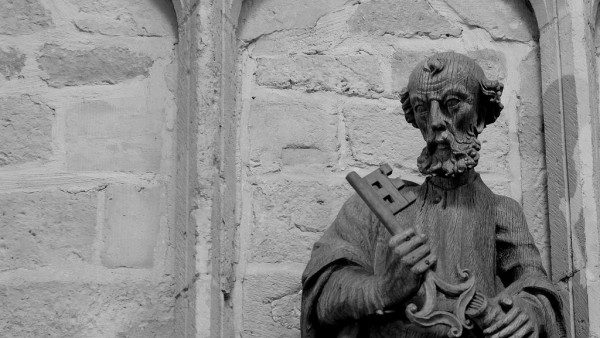In Matthew 16, Simon (soon to be renamed “Peter”) makes his famous declaration that Jesus is “the Messiah, the Son of the Living God.” As is often pointed out with Peter, this is one of the few times he gets something right.

Jesus’ response is more famous yet:
“Blessed are you, Simon son of Jonah! For flesh and blood has not revealed this to you, but my Father in heaven. And I tell you, you are Peter, and on this rock I will build my church, and the gates of Hades will not prevail against it. I will give you the keys of the kingdom of heaven, and whatever you bind on earth will be bound in heaven, and whatever you loose on earth will be loosed in heaven.” (Matt 16:17-19)
Ulrich Luz calls Matt. 16:18 (the text in bold above) a “storm center of exegesis.” That storm swirls around the referent of “rock” in the sentence.
What is this “rock” that Jesus is talking about? What does Jesus say he will build his church upon?
Is the rock Peter’s faith, universally speaking–that is, the faith of all disciples, of which Peter is only one example?
Is the rock the confession of faith in Jesus as the Messiah–or as the divine Son of God?
Is the rock Jesus ? (the person in whom Peter confesses faith)
Is the rock Peter? (the one who draws the right conclusion about Jesus). But will Jesus really build his church upon Peter?
Luz names these four historic interpretive options this way:
1. The “typological” or “democratic” option (Faith).
The church father Origen took this position. “A rock is every disciple…who drank of the spiritual rock [Christ], who followed them.” The implication is that Peter is not unique above all disciples, but that Jesus is pointing out that faith and obedience of all disciples is the basis for the vitality of the church. Peter stands as an example of how we all should respond to Jesus.
2. The Eastern Interpretation (Confession of Faith)
Luz points out that this position, a favorite among the Greek and Syrian churches, extended the democratic impulse of Origen’s view (Peter stands for all disciples) but interpreted the “rock” to refer to something more concrete: the confession of faith in Christ. Theodore of Mopsuestia says, “When Jesus called [Peter’s] confession a rock, he clarified that upon this [confession] he wanted to build his church.” So it was confession that Jesus was and is the divine Son of God that would be the foundation of the true church (against heretical opinions).
3. The Christological Interpretation (Jesus)
Augustine interpreted the rock to refer to Jesus Christ himself–the object of Peter’s exclamation. Luz explains that “Peter is the not the rock, but, as a believer in Christ and as the first apostle, he represents the church. It is not, he could say, that the rock took its name from Peter, but Peter had his name from the petra, the “rock” (60). Luz points out that this “christological interpretation” became the “dominant interpretation of the Western church in the Middle Ages.”
This might surprise some, because Augustine is the most important theologian for Roman Catholicism, perhaps apart from Aquinas. But Augustine’s christological interpretation (the rock is Christ, not Peter) was used by the Protestant Reformers as evidence against the Roman Catholic interpretation, which is the next one to mention:
4. The Roman interpretation (Peter himself).
This view takes the “rock” to be a reference to Peter and sees the play on words (petra = rock; Petros = Peter) as support for that interpretation. While there were a few scattered references to Peter as the bishop of Rome and as the “first pope,” throughout the early centuries of the church and the Middle Ages, it wasn’t until the counter-Reformation that this “Roman interpretation” of Matthew 16:18 became a major interpretive option, when it became fixed in the Catholic church’s interpretation. This interpretation was utilized as a “secondary legitimization” of the Roman papacy against Protestant criticism, as it was seen to support other stronger arguments on behalf of the papacy and apostolic succession.
So which interpretation is the “right one?
Luz suggests that neither of the four options gets it exactly right. There are probably elements of truth, more or less, in each of them. But of the four, the Roman interpretation clearly has the less interpretive legitimacy for Luz, from a biblical studies point of view. I agree.
Luz suggests we should see Peter functioning in the passage both in a typological, or democratic, sense and in a historic and unique sense for being in such proximity to Jesus. The uniqueness of Peter suggests that he “cannot be succeeded by anybody.” And the historical record suggests that “apostolic succession” did not actually occur in the way often suggested, since authority was far more diffuse and localized: “only local elders and bishops” (70).
Democratically, Peter represents “concretely the essence of discipleship for everybody” (70).
This makes the “rock,” upon which Christ founds his church, accessible to all disciples. Faith in Christ, the confession of faith, Christ himself — it is all the basis of the church’s vitality and endurance, from its inception until now.
Source: Ulrich Luz, Matthew in History: Interpretation, Influence, and Effects (Minneapolis, MN: Fortress Press, 1994)











